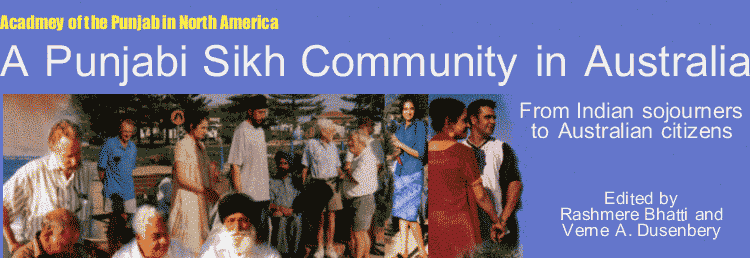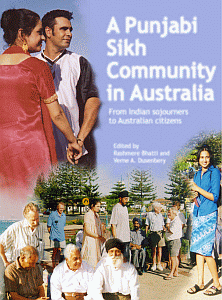
![]()
| English Books | Shahmukhi Books | Gurmukhi Books |
Preface
 This project was developed over a number of years in response to local, national and international curiosity about the Punjabi Sikh community in the Woolgoolga-Coffs Harbour area and how they came to be established on the north coast of New South Wales.
This project was developed over a number of years in response to local, national and international curiosity about the Punjabi Sikh community in the Woolgoolga-Coffs Harbour area and how they came to be established on the north coast of New South Wales.
Rashmere Bhatti, in her role as co-ordinator and community settlement services officer at the Woolgoolga Neighbourhood Centre (WNC), was constantly approached by individuals, groups, students, schools, government departments etc to explain the origins and cultural practices of the local Punjabi Sikh community. Van Dusenbery, as a scholar of Sikh communities in multicultural societies outside of India, had long been intrigued by this unique community and had come to Australia on sabbatical in 1999 to inquire further into how Sikhs were faring in the context of Australian multiculturalism.
In 1998, when the call went out for projects to celebrate Australia's Centenary of Federation in 2001, the Woolgoolga Neighbourhood Centre responded with a submission to put together an account of the local Punjabi Sikh community. The Centenary of Federation (Department of Communication, Information Technology and the Arts) was looking for significant achievements of the past century and the WNC submission argued that the Punjabi Sikh community settling in the area reflected Australia's evolution from the White Australia policies at the time of Federation to the Australian Multiculturalism policies at the time of the centenary of Federation. In addition, it made the case that this project would be a valuable and much-needed resource for cross-cultural awareness and for heritage preservation. Importantly, the project met the criteria of having wide community support by gaining the enthusiastic endorsement of both Punjabis and nonPunjabis in the Cowper electorate at both the official and the community level.
The project was funded in 1999 and was to be completed for Centenary of Federation celebrations in November 2001. A formal launch in January 2000 thanked Garry Nehl, the Member for the Federal seat of Cowper, for funding through the Centenary of Federation program, recognised community supporters and encouraged community participation. Rashmere started the process of reviewing available material, collecting oral histories, visiting sites in the Punjab and Australia and conducting interviews with Punjabis and non-Punjabis in the area. Van, having become appreciative of the project during his fieldwork in 1999, was drawn into the project in July 2000. He brought other Sikh scholars to the project and provided research guidance and editorial suggestions via email from the United States.
The project has come to be a wider collaborative endeavour. Marie de Lepervanche has been a wonderful resource person. Her earlier study of the Punjabi community of Woolgoolga, undertaken in the 1970s and published as Indians in a White Australia in 1984, provided the basis for understanding how the White Australia ideologies, policies and practices affected the community. We thank her for her willingness to share her material and insights for this project. Hew McLeod, the foremost Western historian of the Sikh religion, graciously agreed to contribute the opening chapter of this volume. His many published works provided considerable background information and, via email, he has been invaluable in giving his expert opinion on many special points of fact and interpretation. We thank him for his many contributions to the project. We also thank Ramindar Singh, author of Sikhs and Sikhism in Britain, and Carmen Voigt-Graf, PhD candidate in the School of Geosciences at the University of Sydney, for contributing their essays to the volume.
Our deepest debts are, of course, to the Punjabi and non-Punjabi people of the area who have given so much of their time. It is their insights and the material they have shared with us that have allowed us to depict the events and experiences of the forefathers, the settlers and today's citizens of the area. We thank them for their patience, their hospitality, their forbearance and their interest. We particularly appreciate those who allowed themselves to be quoted in the text and those who contributed Community Voices for the book. We hope we have done justice to their stories.
As a daughter of the village, Rashmere feels honoured to have had the opportunity to record the stories of the forefathers and to pay tribute to their initiative and endurance. She thanks the forefathers for having settled in Australia so that their descendants can now enjoy the rich, diverse life that Australia offers. "As an Australianborn Punjabi Sikh, I value the unique experiences that I have had with both Punjabis and non-Punjabis, at both a professional and personal level, in this community. My being bicultural -at home in both worlds -is what has made this project possible. And I feel that this is exemplary of what it should mean to live in a multicultural Australia. I would like to thank the Punjabi community for their wholehearted support of the project, the non-Punjabi community for their passionate interest in the project, the scholars for their' selfless service to furthering the cause of Sikh studies and the WNC board of directors for their unwavering faith in my ability to see the project through."
As a non-Punjabi American, Van feels honoured to have been allowed to participate in this project. "In the introduction to an earlier co-edited book, The Sikh Diaspora Migration and the Experience beyond Punjab, I had said that Sikh scholars had a role to play in helping Sikhs tell the stories of their communities. Consequently, when Rashmere invited me to be a part of this project, I was pleased to be able to contribute. I feel that this has truly been a liberating venture in bringing together the scholars and the community, and I hope that this will encourage others to combine their talents. I thank the advisory committee to the project and Rashmere for making my participation possible. I also thank the Research Institute for the Humanities and Social Sciences at the University of Sydney for research affiliation in 1999 and Hamline University for Deans grant and Hannah grant support of research, writing and editing work on this project."
This is a portrait of a Punjabi Sikh community having weathered the era of the White Australia Policy and coming to terms with evolving Australian multiculturalism. At this centenary celebration, the reader is invited to reflect upon what it means to live in a multicultural society. Policies alone will not ensure multicultural harmony and equal treatment of all. Rather than be passive observers merely tolerating one another, individuals -both Punjabi and non-Punjabi -need to take the responsibility to reach out to one another as fellow human beings and equal citizens. This is a challenge not only for Australia but for all multicultural societies.
Rashmere Bhatti
Verne (Van) A. Dusenbery
August 2001
![]()